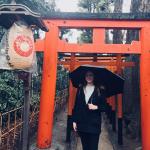Support
With the vast array of abroad programs made available by SLU and the many wonderful international schools they’ve formed partnerships with, studying abroad is something I knew I wanted to pursue at some point over the course of my four years as a SLU student. The choice wasn’t hard for me; I had been interested in travelling to Japan since I was a child and was able to experience the country secondhand through stories my dad, who often travelled to Tokyo on business, told me, and my interest in taking up a Religious Studies minor led me to take several of the courses taught by Dr. Mark MacWilliams, SLU’s resident scholar on religious life in Japan. When I first learned about it, Japan’s notion of religion was unusual to me, as I had only been extensively exposed to Western religions, where one’s religion is often a personal identifier and provides set beliefs for individuals to follow. Japan, however, is a country where the majority of the population do not identify as ‘religious’ in the sense that Westerners do. The country’s two main religions – Shinto and Buddhism – are so ingrained in everyday life and society that most Japanese people do not consider themselves religious; shrines, temples, festivals, and prayers to the kami are simply parts of daily existence to them.
I wanted to further explore the relationship between religion and day-to-day life, and, thanks to the generosity of Mr. Paul B. Gilbert and Mrs. Patricia C. Romeo-Gilbert, I was able to embark upon a trip to Japan’s largest city, Tokyo, over my spring break. The specific focus of my project was to explore how Tokyo’s religious life and sense of neighborhood had developed since its early days as a collection of villages centered around religious places by looking at Shinto shrines and Buddhist temples in the various wards and districts of the city. My project took me across the entire city, and I was able to visit an array of religious spaces, from small outskirt temples like Gotokuji in the Setagaya ward to the massive Meiji Shrine in Shibuya.
Through my research prior to my trip, I had known that Tokyo was a vast city with many shrines and temples within, but what I found when actually conducting my research was more than that. Shrines and temples are everywhere in Tokyo; while on my way to visit one of my charted destinations, I would often stumble across anywhere from one to three more shrines or temples that I hadn’t anticipated, and would take time to explore those, as well. Even in the most populous, bustling areas of the city, the red torii gates that stand at the entrance to every Shinto shrine would be there, beckoning people in. I discovered that many of Tokyo’s neighborhoods had not only built up around these religious spaces, but had also built economies around them. Bentendo Temple in Ueno Park, for example, had a pathway leading up to the temple complex itself that was lined by vendor stalls selling common Japanese street foods to visitors as a way of earning their livelihoods. Additionally, visiting certain shrines and temples seemed to be common practice for certain subsets of Tokyo’s population. Shrines to Inari, the Japanese kami, or deity, of agriculture, industry, and prosperity, were frequented by businessmen. I visited Hanazono Inari, an Inari shrine in the Taitō ward, around lunchtime, and was able to witness a number of businessmen dressed in full suits come to offer prayers for success to Inari.
It was incredible to see how these shrines and temples had become centerpoints around which the city itself had developed and grown. I discovered how unique Tokyo is as a city; amidst skyscrapers and bustling industry, old shrines and temples carve out small places of solitude and quiet contemplation. These religious spaces have fostered a sense of neighborhood and commerce within the city’s wards, and visiting them is a part of everyday life for many Tokyo denizens. I am extremely grateful to have been afforded this opportunity to pursue my project and explore the religious life of Tokyo, and it is an experience I will never forget. I hope to continue my study of Japanese religious life in the future.
